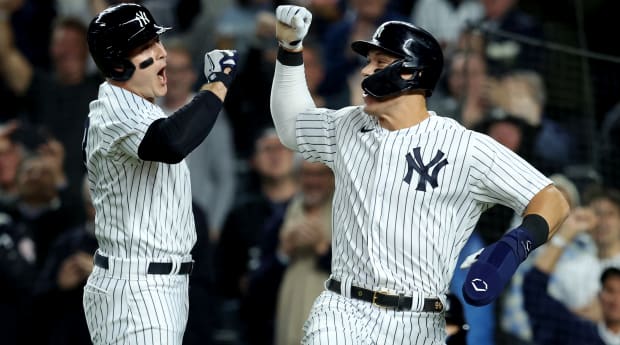
Brad Penner/USA TODAY Sports
How did Anthony Rizzo try to convince Aaron Judge to re-sign with the Yankees? He used the heart-tugging power of man’s best friend.
“I did send him a couple of pictures of our dogs together—because we both have dachshunds—saying, ‘We can’t break them up!’” Rizzo said on The Book of Joe podcast, with me and Joe Maddon, his former Cubs manager.
Rizzo said he wasn’t sure Judge was returning to the Yankees until the day Judge agreed to the nine-year, $360 million deal.
“I wasn’t recruiting as hard as you think,” Rizzo said. “[Wife] Emily and I know him and [Judge’s wife] Sam really well from last year, just getting closer. It was really, ‘What’s going to make you happy? Is it going to be A, B, C or D? Is that here, there or somewhere else?’ And just kind of being more of a friend throughout the process than being a teammate.
“Thinking in that zero hour when everything hit the fan, I was a little bit worried like everyone else. But also, saying, ‘You have to do what makes you happy and what’s going to be what’s ultimately best for you.’”
Judge made his decision Dec. 7. Rizzo re-signed with the Yankees Nov. 15, agreeing to a two-year, $34 million contract, but not before he spoke with Judge.
“I had some conversations with Judge, [to] see what he was thinking, obviously,” Rizzo said. “Emily and I, we decided our top priority was to stay in New York and if that was an option early we would jump on it as long as everything fit right and it did and we’re pumped.”
Rizzo hit 32 home runs last season, the most by a Yankees left-handed hitter in a decade (Robinson Canó in 2012). He is one of the bellwether hitters of how the proliferation of defensive shifts changed the game. Thanks in part to seeing four-man outfields and infield shifts, Rizzo hit .216 when he put the ball in play last season—the lowest such mark of his career. Rizzo saw a shift 83% of the time last season, up from 35% in ’15.
In 2015, when Rizzo hit grounders or line drives to the pull side his BABIP was .342. Those same batted balls last season resulted in a .232 BABIP. Four-outfielder alignments, infield shifts and infielders stationed on the outfield grass are banned next season.
Watch the Yankees with fuboTV. Start your free trial today.
“I know those people in the front office, [with] their analytics, will have their ways of moving their outfielders and whatnot,” Rizzo said “Even that will be [more] beneficial than hitting with ... I think I had a hundred plate appearances with four outfielders. It’s still definitely will be beneficial to all lefties, I know that.”
Rizzo said the introduction of a pitch timer will impact veteran hitters more than the ban against shifts. With the bases empty, hitters must be ready to hit with eight seconds left on the 15-second pitch timer. Rizzo’s median time between bases-empty pitches last season, adjusted for pitch-timer protocols, was 14 seconds, which ranked among the slowest 6% of hitters.
“Honestly, I think the biggest adjustment for those of us in the big leagues is going to be the pitch clock, hitting-wise,” he said. “Just because a lot of us have had our set hitting routines. You know, you get out of the box, you readjust your batting gloves … to where you noticed last year, especially at the end last year when you get a lot of guys called up from Triple A, guys are ready to go and you’re feeling rushed, rushed, rushed. This offseason will definitely be an adjustment I make just to make sure after a swing you get back up right away to hopefully reset a little quicker than you would in the past.”







